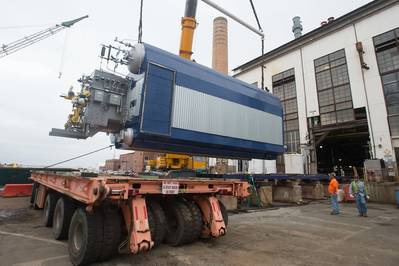Huntington Ingalls Industries (HII) announced today that its Newport News Shipbuilding division has converted its steam-generation plant from heavy fuel oil, also known as Bunker C, to natural gas to improve safety and lower operating costs and emissions to the environment.
The plant generates low-pressure steam to heat many of the shipyard’s facilities, to provide process heat and to support hotel services—including hot water, food preparation and galley services—to the ships undergoing construction and overhaul.
“We started researching and evaluating alternative options about four years ago with the goal of implementation by 2016,” said Bill Cash-Robertson, a Newport News Shipbuilding environmental engineer. “Not only does the conversion to natural gas make good business sense, it’s more efficient, it’s cleaner, and it’s safer to operate.”
The old system, which included three 70-year-old boilers, burned about 6 million gallons of heavy fuel oil last year, costing the shipyard about $15 million. Plant Engineering Supervisor Ken Allmon, a member of the shipyard’s energy management team, said the new system will reduce greenhouse gases by 30 percent and save the shipyard several million dollars per year in lower utility costs. “The team is proud of our work to overcome technical challenges and implement a solution that is a win for everybody,” he said.
Will Koeck, the project’s construction engineer, said one challenge was to safely remove and install large boilers in a plant that had to continue operating during the conversion. “We met the challenge with careful coordination and planning, and we had the first new boiler in place making steam in December 2014,” he said.













